
Photo by Michael Jasmund on Unsplash
My third-story apartment in Jerusalem gets pleasant breezes on warm days, so I often leave the windows open. My window screens, however, have proven to be remarkably ineffective at keeping bugs out. I have to accept some bad with the good.
My book, ArchitecTorah: Ideas in Judaism and the Weekly Torah Portion, focuses on the many places where Judaism interacts with architecture. The window presents a perfect example of this intersection.
Accepting the bad and the good is the type of tradeoff that comes with having holes in your walls. While windows give access to light, fresh air, and scenic views — rows of rooftop water heaters, in my case — they also cause problems. A window makes a good emergency exit, but also a good point of entry for thieves or mosquitoes. A room with a view is nice, but others can peep in as surely as we can look out. Ventilation is hugely important, but no one wants extra cold and dampness seeping in during the winter. Sunlight is great, but sometimes you want to nap in the daytime. A window needs to be, oxymoronically, an open barrier.
Thankfully, there are inventive ways to make this possible. Early windows were just openings in the wall, usually placed high up as a security measure. At some point people began installing glass or paper as a translucent barrier, quite an innovation. However this blocked ventilation, so louvers and operable windows were invented. Once a window could be opened, screens and bars were needed to keep insects and robbers out and children safely in. These bars obscured views, however, so recently, plexiglass bars have become a versatile alternative. Layered glass helps keep out harmful UV rays, insulates against the elements, and keeps shattered glass from scattering. Sunshades, blinds, shutters, and awnings help control privacy and excessive sunlight. Each innovation helps maximize the utility of a window while minimizing its harm.
I’m focusing on windows not because there is something particularly Jewish about them, but because I want to point out that they frequently appear in Jewish writing, including the Torah and rabbinic literature. The Talmud debates whether the window opening is considered inside or out. Among the window-related innovations I listed, the Talmud mentions transparent film, window bars, louvers, blinds, and shutters. We live our lives surrounded by architecture, so it is not surprising that there are many references to building details in these texts.[1] The Jewish sources are not trying to influence design or instruct how to build, they are simply analyzing the built environment of their era and considering it from within the halls of the beit midrash.
Principles voiced by Louis Kahn, Louis Sullivan, or Le Corbusier can prompt new interpretations of a passage in the Talmud, whether about sacred space, skyscrapers, or ribbon windows.
In my book, ArchitecTorah: Ideas in Judaism and the Weekly Torah Portion, each short essay begins with a verse in the Torah, organized according to the weekly Torah portions. Some concern passages in which architectural analysis adds depth to a biblical story. For example, we find Lot interacting with the people of Sodom at his front door, Jewish slaves making bricks in Egypt, and, apropos to our discussion, Abimelech glimpsing Rebecca and Isaac through an open window.
Other chapters in ArchitecTorah introduce pieces of architectural theory or conceptual buildings and use them to reexamine passages in the Torah. Principles voiced by Louis Kahn, Louis Sullivan, or Le Corbusier can prompt new interpretations of a passage in the Talmud, whether about sacred space, skyscrapers, or ribbon windows. While these ideas may be familiar to trained architects, others will also find that the book contains many lessons about design, in addition to explorations of Torah.
Returning to the subject of windows, in one chapter I consider the blessing of the prophet Balaam, “How goodly are your tents,” and the subsequent parsing of this text by the Sages of the Mishnah and Talmud. The Talmud suggests that Balaam was praising how the openings of Israelite tents were staggered to preserve privacy. The Talmud consequently bans the construction of new windows in close proximity to existing ones. However, the Sages also recognized the importance of sunlight, ruling that one cannot block existing access to the sun’s rays. These two values – having sunlight, but not impinging on the modesty of others – are potentially in conflict and need to be balanced.
We find these same topics and tensions mirrored in secular law. Regulations protecting access to sunlight are common, what in England is called “ancient lights.” In the United States this is mainly accomplished with building codes demanding setbacks and shadow analyses. We also find building codes that limit the proximity of structures to help ensure privacy and ventilation, social-minded laws that were a response to tenement conditions. One of the undercurrents of ArchitecTorah is that Jews have always lived in the same built world and material culture as their neighbors and grapple with the same issues. The Mishnah, for example, distinguishes between Syrian and Egyptian windows, reflecting the two dominant cultures that neighbored Israel before the Roman conquest. The architecture of the First Temple mirrored contemporary temples of the surrounding region, while Herod’s renovation remade the Second Temple as a Classical precinct. Synagogue design has historically reflected the architecture of the host culture. It is unsurprising that architectural discussions taking place in the world at large can be applied to Jewish sources, with fruitful results.
This analysis and application of architectural ideas is at the center of ArchitecTorah. Studying the Torah through the lens of architecture opens up novel points of view. It gives readers both new perspectives on our texts, and a deeper appreciation of the built environment around us.
[1] Tosefta Eruvin 8:14, Mishnah Ohalot 8:4, Mishnah Ohalot 13:1, Babylonian Talmud Niddah 17a, and Mishnah Shabbat 25:5.
Joshua Skarf is a licensed architect living and working in Jerusalem. He studied in Yeshivat Har Etzion and has degrees in architecture from the University of Michigan and Bezalel Academy. He has designed hospitals, train stations, shopping malls, Israeli consulates, army installations, elementary schools, museums, and research facilities in Israel. Skarf was born in Toronto, grew up in Michigan, and has been living in Israel since 2004.
